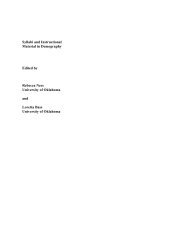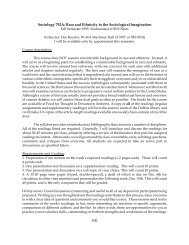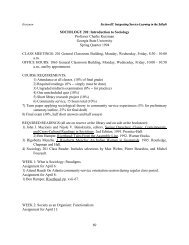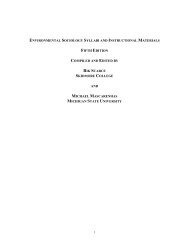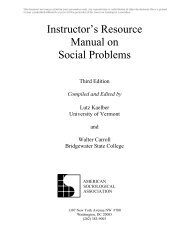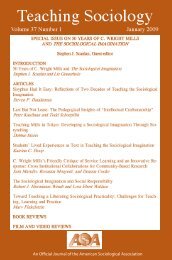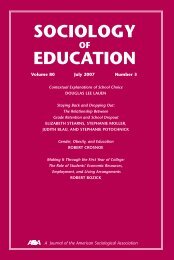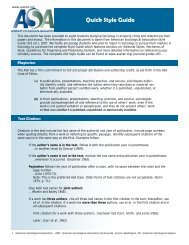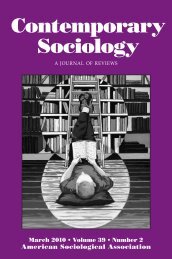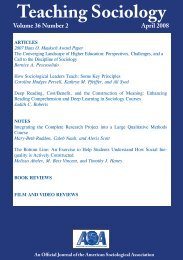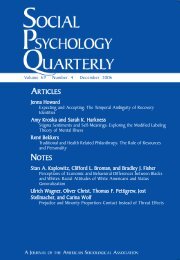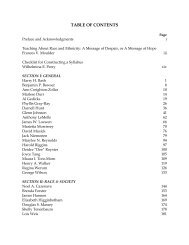SOCIOLOGY EDUCATION - American Sociological Association
SOCIOLOGY EDUCATION - American Sociological Association
SOCIOLOGY EDUCATION - American Sociological Association
You also want an ePaper? Increase the reach of your titles
YUMPU automatically turns print PDFs into web optimized ePapers that Google loves.
Another Way Out 387<br />
Such research will yield richer theoretical<br />
implications and more specific policy prescriptions.<br />
In the meantime, scholars and<br />
practitioners in the educational and juvenile<br />
justice fields should take stock of the finding<br />
that juvenile justice intervention is a frequent<br />
pathway to school dropout, especially in poor<br />
urban neighborhoods. This finding should<br />
weigh on the minds of gatekeepers—including<br />
school security and disciplinary agents—<br />
and decision makers in the juvenile justice system<br />
when they consider whether and which<br />
legal intervention serves the best interest of<br />
the child and the community. And it should<br />
register on the radar of officials who want to<br />
identify and address the sources of the urban<br />
“graduation crisis” that are most driven by<br />
and, therefore, most amenable to official<br />
intervention.<br />
NOTES<br />
1. Juvenile court jurisdiction in Illinois ends<br />
at 17, and reliable data on court involvement<br />
is available until July 2001. Accordingly, the<br />
base for this calculation includes only the<br />
1,917 black male students (of 5,191 students<br />
overall) who were, by this time, at least 17<br />
and living in Chicago.<br />
2. CSDP in Chicago was a randomized<br />
“whole-school” reform initiative that sought<br />
to improve schools’ academic and social climates<br />
by integrating parents and mental<br />
health professionals into the operations and<br />
management of the schools (Cook et al.<br />
2000).<br />
3. Since seasonal variation in “nonarrest”<br />
dates could confound the impact of arrest<br />
and dropout, nonarrested cases are randomly<br />
assigned to one of five periods proportionate<br />
to the seasonal distribution of actual first<br />
arrests. These periods were summer (20 percent),<br />
early fall semester (12 percent), later fall<br />
semester (31 percent), early spring semester<br />
(23 percent), and later spring semester (13.5<br />
percent). Cut-off points for “early” and “later”<br />
are the Chicago Public Schools-wide biannual<br />
“snapshots” that fall near October 1 and May<br />
1. Next, within these assigned periods, I randomly<br />
assigned reference dates on which<br />
enrollment status was comparably measured.<br />
4. Youths whose reference dates occurred<br />
in the summer prior to the ninth grade were<br />
eligible only if they were enrolled at the end<br />
of eighth grade (based on the final departure<br />
date). Additional measures were<br />
employed to reduce the number of “false<br />
positives” on the measures of enrollment<br />
status, since a disproportionate share of<br />
false positives in the arrested group would<br />
inflate the adverse effects of arrest. First,<br />
police records indicate arrestees’ self-reported<br />
school enrollment at the police station.<br />
Students who fail to claim school enrollment<br />
are recorded as not enrolled unless this designation<br />
conflicts with other information in<br />
the school record (e.g., semester GPA and<br />
absences). Second, arrested cases that were<br />
coded as early or mid-dropouts were examined<br />
on a case-by-case basis to verify that<br />
they were enrolled at the time of their reference<br />
dates. For example, a score on an<br />
achievement test provided solid evidence<br />
that students were enrolled at the time of<br />
the March or April reference dates. Also<br />
informing this determination were students’<br />
particular levels of grades, absences, and<br />
course credits. See Hirschfield (2003) for<br />
further details on measurement procedures<br />
and criteria for enrollment status, as well as<br />
the procedures for merging data.<br />
5. About 95 percent of students enrolled in<br />
these grades participated each year. Twelve of<br />
these schools began implementation and survey<br />
participation in 1993-94. Three of the 22<br />
schools dropped out of the study before the<br />
conclusion of the evaluation period.<br />
6. Because students often remain officially<br />
enrolled after they stop attending school<br />
(LeCompte and Goebel 1987), dropout<br />
behavior was measured through the beginning<br />
of the next school year as opposed to<br />
the end of the current one. Four percent of<br />
the mid-dropouts dropped out during the<br />
first two weeks of Year 3, and about 5 percent<br />
of the early dropouts similarly departed at the<br />
beginning of Year 2. The drawback of this<br />
measurement frame for early dropout is that<br />
22 percent of the nonarrested comparison<br />
group (n = 33) were arrested in the summer<br />
prior to Year 2. None dropped out after their<br />
arrests, so these cases do not violate the<br />
integrity of the research design.<br />
7. The majority of early and mid-dropouts<br />
(roughly 70 percent) and final dropouts (60<br />
percent) did not formally dropout. Rather,



